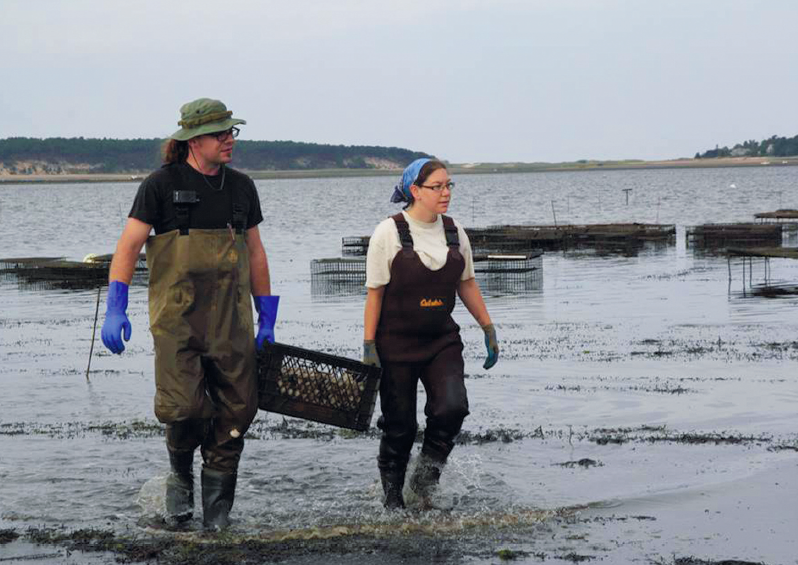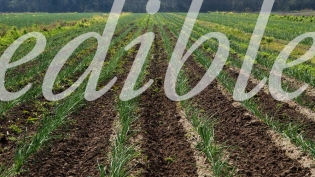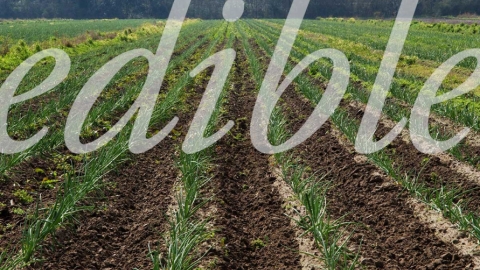Seafood Traditions of Fishing Families
As commercial fishermen, when our backs ache, or we’re digging steamer clams in the cold and wind, or if we’ve been offshore for a few days away from family and are wondering how to pay all the bills, we can forget that fish is an enjoyable source of food. The challenging work environment makes it hard to imagine others consuming and enjoying the fruits of our labor, and we rarely get to meet the people who purchase our fish.
Many fishermen, however, incorporate their catch into their own weekly meals, holidays, and family gatherings. The diverse seasonality of fisheries on Cape Cod lends itself to an impressive array of fish and shellfish dishes among fishing families from across the region.
Most people go to the fish market, have a mission to buy exactly what they want, and fulfill it. What they may not realize is that true local seafood on Cape Cod is very seasonal. For instance, bay scallop season starts October/November and lasts only for the winter. Inshore squid season only runs through the spring. Steamers cannot be dug when air temperatures drop below freezing. Certain species of fish, like striped bass, are fished until an aggregate number of pounds have been caught throughout the state. For those fisheries, we don’t know when the season will end for sure, as there are so many factors influencing the rate of catch. Therefore, in every fishing family there’s usually a clear beginning and an uncertain end to any fishing season. Some families celebrate either the opening day or the final days of a given season with the bounty of their catch, honoring the harvest.
Many Cape Cod fishing families participate in more than one fishing season throughout the year. Our family is a great example. We fish the weirs from April to August, we shellfish during the summer and fall, and bay scallop in the winter. We have three fishing seasons, which makes for multiple seafood celebrations during the year. With the first squid catch we bring in from the weirs in May, we gather friends and family to the house and Shannon’s mom, Shareen, makes her famous baked calamari. We talk about the day, past seasons, and record-breaking years gone by. The fishers tell of battle wounds from days when the boats were so full of fish coming into the harbor, the rails were practically underwater.
Late in our trap season, we catch bonito, which is one of the most delicious and sought-after sushi-grade fish because of its incredible flavor and tender texture. No matter what the circumstances, the very first bonito caught in our trap is saved for the family. We fillet it immediately, and prepare a world-class sashimi-style dinner. By the next haul, word has spread and we are getting requests for this highly coveted fish among the inner sanctum of fishing families.
In the summer, we have an annual beach event called the Clam Shack, born out of the memory of the old Stage Harbor Clam Shack long gone since the 1960s. Along with friends and family, we ferry all the makings of a traditional clam fry to the outer beach, including the original signage from the old shack, and have feast of fried clams, sea scallops and homemade onion rings.
When the fall winds become frosty in the morning, bay scallop season has begun. This precious shellfish, only harvested for a few months every year off the shores of the Cape & Islands, has been described as the ocean’s shellfish gold standard. After towing a few hours for bays, the next few hours are dedicated to opening the bivalves and shucking their succulent meats; the event often paired with something hot in a crockpot and warming in a communal flask. Opening day in our family is always accompanied by the highlight dinner of the year: Bays and Tots. All the young children in the family look forward to this meal; how can you go wrong with fried bay scallops and tater tots? So simple, so good.
Upon thinking about our own traditions, we began to wonder how some of our fishing family friends are influenced by their seasonal harvests.
Before she met her husband Billy, Alison Barabe’s rare encounter with seafood consisted of baked stuffed lobster and fried clam strips. Then she married a fisherman, who happens to be an avid hunter, and her entire food world changed. “We have two fridges with freezers attached, and a stand-alone freezer to accommodate everything. I don’t shop at a fish market and when I try I am so lost. I just grab a bag from our freezer or something fresh in the fridge.” Virtually every night spent cooking at home incorporates food produced by Alison’s husband Billy.
Billy Barabe grew up in Chatham, and started fishing when he was 17 years old. For more than 20 years, he’s crewed on many vessels in the fleet, or run his own boat; he has at times walked away from off-shore fishing, and gone clamming on the near-shore flats. He has horseshoe crabbed, dogfished, weir fished, scalloped, quahogged, and musseled. And every kind of fish he’s harvested has landed on the Barabe household dinner table, teaching daughter Laura, 13, the values of fresh, in-season food and consuming the fruits of your own labor.
A family favorite is Poor Man’s Surf & Turf, which the Barabes reinvent for different seasons of fishing and hunting. Alison recounts, “One of our most memorable combos is venison back straps (like little filets of glory), as the ‘turf,’ to go with baked fluke roll-ups stuffed with lobster.” When oyster season opens in the fall in Chatham, it’s angels on horseback, a local favorite of freshly shucked oysters soaked in white wine, then baked wrapped in bacon. Oftentimes, the most basic preparation of fish with little to no other ingredients involved yields the best seasonal dish: grilled striped bass in July, raw tuna in the fall, baked bay scallops in December, and fried calamari in the spring.
Like many fishing families around the Cape, the Barabes are friends and relatives with other fishermen. So it comes as no surprise when a random bag of fresh fish is delivered right to their doorstep. “It is wonderful when we get bags of goodies gifted to us. I love scallops from our scalloper friends, squid from our weir friends, and lobster from our lobster friends.” (Right about now, you’re thinking: must be nice, huh?) But the random fishy gifts and abounding freezer full of Billy’s catch have met the sad reality of New England fisheries. “We have been together for 16 years and I have watched our freezer bounty change from tons of light-colored bags of glorious fish to more dark-colored packages of store-bought meat,” says Alison. As fishermen begin to catch more underappreciated species, some of their families are embracing change and adapting the weekly dinner menus to include fish like monk, dogfish, and scup. The Barabes are no exception. Their new favorite is fried skate cheeks, and Alison is happy to report the return of fish goodie bags to their fridge and freezer.
Becca Taylor comes from a multi-generational shellfishing family in Wellfleet. When she’s not catching babies as a professional homebirth midwife, she’s tending her oyster and quahog grant with husband Sam Blakeslee out in Cape Cod Bay. “We prefer not to work when the temp is below freezing. Bad for us and bad for the shellfish!”
The Taylor Clam Ranch off Mayo Beach has been the family’s shellfish farm for nearly 70 years, starting with Becca’s great uncle, which he passed to her father. As soon as Becca was of legal age, her father signed her into the grant, and she’s been harvesting littleneck quahogs and oysters alongside her sister, father and husband part-time to supplement their household income from other work. It is very common on Cape Cod for fishermen to diversify their work base, as some seasons are more lucrative than others, or uncertainties can arise with regulations and resources. Shellfish farmers are vulnerable because of fluctuations in water temperature or bacteria, which can cause the demise of an entire season. So, fishermen and shellfish farmers often have a huge skill set beyond their primary work, and are very creative with incorporating their harvest into everyday meals or as gifts.
“We always bring oysters to family gatherings. We even shucked our own oysters to pass around at our wedding,” Becca recollected. They regularly swap fresh bags of oysters or necks for finfish or scallops harvested by other fishing families. When asked about a favorite recipe or tradition, Becca and Sam both laughed and said, “We take a knife to the beach, keep one in the truck, one in the pockets of our waders and eat our oysters raw, right off the grant.”
Bob and Rose Denn were a young couple in the early 1970s working seasonally in various fisheries in Chatham. “Every Friday, Ritchie Eldridge would deliver 50 bags of scallops and that was our weekend job. It’s how we paid our mortgage back then…shucking scallops.” Bob had been a long-liner for codfish, a fish packer at the Chatham fish pier, and a shellfisherman. The fishing industry was thriving and there were abundant employment opportunities. Rose shucked scallops, shellfished, and made gill nets for the fleet. She also ran a VHF relay station for NOAA to collect weather data from the boats that were out at sea. She would compile all the reports made by fisherman and relay that data back to NOAA so they could comprise weather reports and weather warnings. “Everything we did was somehow in the fisheries,” she recollects, “and we didn’t have any big plans for the future. We just worked.”
In 1975, Billy Nichols and his wife Peach hired Bob Denn to paint and stock shelves at their new business venture, Cape Fishermen’s Supply. Just months after the store opened, Billy became very sick with cancer and passed away. Bob fell into managing the store and learning the business. In 1989, Peach sold the store to Bob and Rose, and it continued to grow for the 23 years they owned and operated it, and still thrives today with Dave and Caroline Libby at the helm. Bob and Rose were well known by fisherman for their down-home friendliness and well-stocked store where any fisherman could find just about any bolt, line, shackle, tool, chain—any component you’d need on a boat right down to gloves and warm socks.
When we talked with Rose about her favorite fish preparation, Bob chimed in, “Whatever was in season or whatever we were catching, that’s what we ate, unless a friend dropped by with a lobster.” “You know,” Rose says “it’s not like you’re going to the store and buying exactly a pound of cod. If someone swings by with a few fillets of bass, you really don’t know how much you have, so recipes were not measured. In fact, they really came about because you’d say to yourself, ‘Okay, we’re having bass for dinner…what do I have in the house to go with it?’” She laughed, “Like in the case with Kenny Eldridge. He had this awful-sounding recipe that was absolutely delicious. He’d put a light coating of mayonnaise on the bass and drizzle maple syrup on top, then grill it. It was fabulous! You have to try it sometime!” She adds, “When you have a super fresh piece of fish, sometimes a simpler preparation is better than getting too tricky. The fish is delicious on its own.” Rose is a very accomplished cook, especially in the seafood department after years of literally living on the local seafood. You can find a recipe from her kitchen at the end of this article.
Some of the less popular species that are landed right here on Cape Cod have yet to work their way onto our restaurant and non-fisherman home menus. Skate wing is tender and flaky; scup is similar to bass; monkfish pan-seared or in a Cajun stew is amazing; fried sea robin tails are delicious; and sautéed butterfish are a delicacy. Fishermen have long known the tasty variety of fish culled from these waters and wonder why many of them have not become popular amongst the locals here. I remember seeing old photos of the weir fishing boats, so full of tuna that it looked like the boats were about to sink. Back in the 1950s, most of these fish were sold for just a few pennies per pound for cat food. Then in the 1990s, tuna became the most desired and most expensive fish around. Everyone “discovered” tuna. Lobster was once considered a poor man’s food, thought to be ugly and unappealing. As one lobsterman told me that his grandfather caught lobsters and they were primarily sold to the prisons to feed the inmates.
At some point, perception changed and now lobster is an iconic New England delicacy. Times change. The key is that once you have skate wing prepared properly, you’ll love it, and you’ll wonder why you haven’t been eating skate all along. This is true of so many under-appreciated species of fish that are caught locally, such as dogfish and scup. Just ask a local fisherman what he catches and how to prepare it. Voila! You’ll have a whole new fish to put on the menu, and a new way to celebrate the bounty of the ocean that we all love so much.







